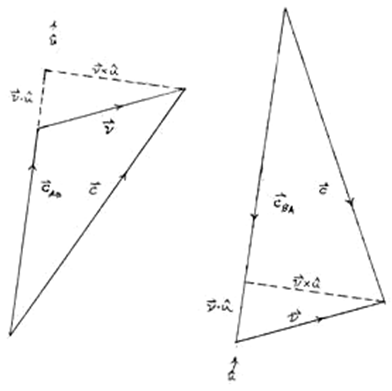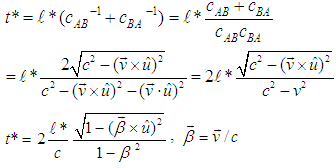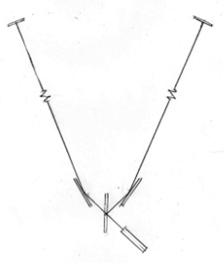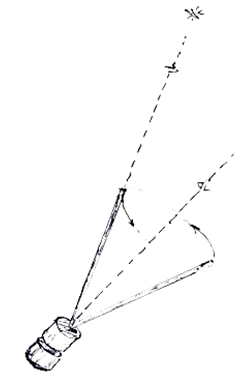-
Paper Information
- Paper Submission
-
Journal Information
- About This Journal
- Editorial Board
- Current Issue
- Archive
- Author Guidelines
- Contact Us
International Journal of Theoretical and Mathematical Physics
p-ISSN: 2167-6844 e-ISSN: 2167-6852
2017; 7(2): 21-24
doi:10.5923/j.ijtmp.20170702.01

Lorentz vs Einstein: A Proposal to Test the Existence of the Aether
Jack Heighway
NASA Lewis Research Center, United States
Correspondence to: Jack Heighway, NASA Lewis Research Center, United States.
| Email: |  |
Copyright © 2017 Scientific & Academic Publishing. All Rights Reserved.
This work is licensed under the Creative Commons Attribution International License (CC BY).
http://creativecommons.org/licenses/by/4.0/

The length of a physical object as measured by electromagnetic echo-ranging is shown to depend upon its disposition with respect to the motion of the earth through the aether. The effect is miniscule, being proportional to (v/c)4where v is earth’s velocity with respect to the presumed aether rest frame and c is the velocity of light. Nevertheless modern techniques, such as employed in the LIGO experiment, are believed to be capable of measuring the effect. Thus it appears that it is may be possible to succeed where Michelson and Morley failed - namely, to measure the velocity of the earth with respect to the aether, and to prove thereby that the aether actually exists. An elementary design for an experiment is proposed.
Keywords: Aether, Cosmic Background Radiation, Modified Michelson Interferometer
Cite this paper: Jack Heighway, Lorentz vs Einstein: A Proposal to Test the Existence of the Aether, International Journal of Theoretical and Mathematical Physics, Vol. 7 No. 2, 2017, pp. 21-24. doi: 10.5923/j.ijtmp.20170702.01.
Article Outline
1. Introduction
- According to the accepted interpretation of special relativity, the aether concept is not necessarily incorrect, it is merely superfluous. Put more sharply, even granting aether’s existence, it is held that no experiment can possibly give evidence of this preferred frame of reference. In this paper, it is shown that the length of a physical object as measured by electromagnetic echo-ranging depends upon its disposition with respect to the motion of the earth through the aether. An elementary design for an experiment is proposed.
2. Distance by Echo Ranging
- It seems reasonable to assume that the cosmic background radiation field (CBR) was, and is, homogeneous and isotropic in some frame of reference, which, without hesitation, we assume to be an aether frame. The calculations are made in a frame at rest in the aether, with respect to which the frame of the earth and the proposed interferometer apparatus moves with velocity
 , as inferred from the Doppler shift dipole of the CBR data. Let
, as inferred from the Doppler shift dipole of the CBR data. Let  (see the Appendix) be a unit vector parallel to the straight line directed from A to B, the inner and outer endpoints of an arm of the interferometer. It is assumed that the device is pointed so that
(see the Appendix) be a unit vector parallel to the straight line directed from A to B, the inner and outer endpoints of an arm of the interferometer. It is assumed that the device is pointed so that A light signal will follow the straight path from A to B, with velocity
A light signal will follow the straight path from A to B, with velocity  of magnitude,
of magnitude, (figure on left), And from B to A
(figure on left), And from B to A  of magnitude,
of magnitude,  (figure on right)
(figure on right) Let
Let  be the true distance1 between A and B measured in the aether frame. The true round-trip echo-ranging time from A to B and back is then
be the true distance1 between A and B measured in the aether frame. The true round-trip echo-ranging time from A to B and back is then Since the experimenter’s clock runs slow by the factor
Since the experimenter’s clock runs slow by the factor his measured round trip time is
his measured round trip time is  Let L be the length of the interferometer arm when the apparatus is at rest in the aether, and recall that
Let L be the length of the interferometer arm when the apparatus is at rest in the aether, and recall that  is the true length of the arm as it moves through the aether:
is the true length of the arm as it moves through the aether: Conventionally, the echo ranging distance is the speed of light times half the round trip echo time:
Conventionally, the echo ranging distance is the speed of light times half the round trip echo time:
3. Distance by Measuring Rod
- Since measuring rods are shortened by the same factor as affects the interferometer arm,
 How the length of an object, as measured by electromagnetic echo ranging, depends upon its disposition with respect to the motion of the earth through the aether
How the length of an object, as measured by electromagnetic echo ranging, depends upon its disposition with respect to the motion of the earth through the aether Finally,
Finally,  to fourth order in β.Remarkably, the difference vanishes if the interferometer arm is either parallel to, or at a right angle to the direction of motion. At the maximum, when
to fourth order in β.Remarkably, the difference vanishes if the interferometer arm is either parallel to, or at a right angle to the direction of motion. At the maximum, when  is 45° from
is 45° from  one has
one has Note that for the standard Michelson Interferometer the above delay is the same for both the right and left arms of the device since
Note that for the standard Michelson Interferometer the above delay is the same for both the right and left arms of the device since , &
, &  Thus the Michelson-Morley experiment was not affected by the effect described here. Heighway, J. (2011), Michelson, A.A. and Morley, E.W. (1887), Michelson, A.A. (1904). From the observed anisotropy of the CBR field, the inferred velocity of earth with respect to the aether is about 627 km/sec, whence
Thus the Michelson-Morley experiment was not affected by the effect described here. Heighway, J. (2011), Michelson, A.A. and Morley, E.W. (1887), Michelson, A.A. (1904). From the observed anisotropy of the CBR field, the inferred velocity of earth with respect to the aether is about 627 km/sec, whence  By comparison, LIGO claims to detect a displacement of 10-18 m over the 40 km between mirrors,
By comparison, LIGO claims to detect a displacement of 10-18 m over the 40 km between mirrors, 

4. Elementary Design for an Experiment
- The apparatusA simple modification of the Michelson interferometer puts the two arms at 45° with respect to one another. If one arm is oriented parallel to, or at a right angle to earth’s velocity with respect to the aether frame, no echo-ranging time increase will be observed. In this situation the other arm will exhibit the maximum effect. In the experiment, one arm would be pointed directly at the ‘hot spot’ in the CBR field, leaving the other at a 45° angle. Consider tracking two wave fronts separated by the beam splitter. After one circuit out and back, the wave that is directed to the arm lying at 45° to the direction of the ‘hot spot’ in the CBR will lag its twin by the distance
 Each subsequent circuit will add the same amount, so after N transits the lag will equal
Each subsequent circuit will add the same amount, so after N transits the lag will equal corresponding to a phase shift,
corresponding to a phase shift,  The tentative design borrows the optical system of the LIGO experiment, which is adopted as is: The light source is a Nd:YAG laser operating at
The tentative design borrows the optical system of the LIGO experiment, which is adopted as is: The light source is a Nd:YAG laser operating at employing Pound-Drever-Hall stabilization, and Fabry-Pérot cavities to enable multiple reflection of the laser beam, etc. We have estimated
employing Pound-Drever-Hall stabilization, and Fabry-Pérot cavities to enable multiple reflection of the laser beam, etc. We have estimated  Following LIGO, we set N = 75. As to length, it would seem feasible to set L = 60m. Again, following LIGO, we set
Following LIGO, we set N = 75. As to length, it would seem feasible to set L = 60m. Again, following LIGO, we set  For these choices,
For these choices,  Detecting such a fringe shift is within present capability, but the enormous size of the apparatus will present many problems.
Detecting such a fringe shift is within present capability, but the enormous size of the apparatus will present many problems.  Operation of the InterferometerIdeally, the device will be mounted so that the arms of the interferometer can interchange positions by a 180° rotation about the centerline between the arms. This will permit observation of the fringe shift at interchange without changing the orientation of the entire device. It will also permit correcting for differences in arm length, by stopping halfway through the interchange, where there should be no difference in transit time.
Operation of the InterferometerIdeally, the device will be mounted so that the arms of the interferometer can interchange positions by a 180° rotation about the centerline between the arms. This will permit observation of the fringe shift at interchange without changing the orientation of the entire device. It will also permit correcting for differences in arm length, by stopping halfway through the interchange, where there should be no difference in transit time. Site of the ExperimentOn EarthIf the experiment is to be conducted on the earth, the device must be mounted on a telescope-type platform capable of tracking the ‘hot spot’ (*), the galactic longitude and latitude of which are2
Site of the ExperimentOn EarthIf the experiment is to be conducted on the earth, the device must be mounted on a telescope-type platform capable of tracking the ‘hot spot’ (*), the galactic longitude and latitude of which are2  corresponding to Right Ascension
corresponding to Right Ascension  and Declination
and Declination  in the equatorial system. The terrestrial longitude at any time, t, may be determined from the right ascension and the longitude of the first point of Aeries,
in the equatorial system. The terrestrial longitude at any time, t, may be determined from the right ascension and the longitude of the first point of Aeries,  For latitude,
For latitude,  of course.According to the aether theory, the only interaction between the aether and a material body (even the entire earth) is a tiny contraction of the body in the direction of motion through the aether, well accounted for in the above analysis. Thus the interferometer need not have a clear line of sight to the ‘hot spot’: in fact, the interferometer may be directed along a line that cuts through the earth: it may even be directed to any point lying 90° from the ‘hot spot’. No location is ruled out. Some of the difficulties inherent to an earth-bound experiment include the provision of a large vacuum system, a complex positioning system, and systems to maintain the length of the arms of the interferometer.The experiment might even be conducted in a large lake so that buoyancy would eliminate bending stress on the (tubular) arms of the interferometer. A lake location would also provide a stable temperature environment, and eliminate uneven heating effects present in above-ground sites.In SpaceAlternatively, the experiment could be conducted in space. The space environment has the advantage of not requiring a vacuum system, as well as eliminating bending stresses on the arms of the interferometer (small tidal forces would still be present). Because the uneven heating of solar radiation could pose a serious problem, the experiment could perhaps be conducted in the shadow of the earth at the Lagrangian point, L2. This is not perfect since L2 is located approximately 1.5 million km from Earth, while the umbra of the earth’s shadow extends only 1.37 million km. I have calculated that at L2 the sun’s brightness is reduced to about one-seventh of full value. Regardless of location, the arms of the interferometer could be protected by solar shields covered with photovoltaic cells to provide power. The ecliptic coordinates of the ‘hot spot’ are l = 180°, b = – 30°.
of course.According to the aether theory, the only interaction between the aether and a material body (even the entire earth) is a tiny contraction of the body in the direction of motion through the aether, well accounted for in the above analysis. Thus the interferometer need not have a clear line of sight to the ‘hot spot’: in fact, the interferometer may be directed along a line that cuts through the earth: it may even be directed to any point lying 90° from the ‘hot spot’. No location is ruled out. Some of the difficulties inherent to an earth-bound experiment include the provision of a large vacuum system, a complex positioning system, and systems to maintain the length of the arms of the interferometer.The experiment might even be conducted in a large lake so that buoyancy would eliminate bending stress on the (tubular) arms of the interferometer. A lake location would also provide a stable temperature environment, and eliminate uneven heating effects present in above-ground sites.In SpaceAlternatively, the experiment could be conducted in space. The space environment has the advantage of not requiring a vacuum system, as well as eliminating bending stresses on the arms of the interferometer (small tidal forces would still be present). Because the uneven heating of solar radiation could pose a serious problem, the experiment could perhaps be conducted in the shadow of the earth at the Lagrangian point, L2. This is not perfect since L2 is located approximately 1.5 million km from Earth, while the umbra of the earth’s shadow extends only 1.37 million km. I have calculated that at L2 the sun’s brightness is reduced to about one-seventh of full value. Regardless of location, the arms of the interferometer could be protected by solar shields covered with photovoltaic cells to provide power. The ecliptic coordinates of the ‘hot spot’ are l = 180°, b = – 30°.Appendix
- The unit vector
 is assumed to be parallel to the arm of the interferometer as observed in the aether system of reference. Because of the contraction effect,
is assumed to be parallel to the arm of the interferometer as observed in the aether system of reference. Because of the contraction effect,  is not aligned with the arm as observed in the moving system of earth, in which the arm lies parallel to the unit vector
is not aligned with the arm as observed in the moving system of earth, in which the arm lies parallel to the unit vector  But because observations made in the moving frame are subject to the same shortening effect,
But because observations made in the moving frame are subject to the same shortening effect,  will be identical to the vector observed in the aether frame in the situation in which the arm is at rest in the aether. In general
will be identical to the vector observed in the aether frame in the situation in which the arm is at rest in the aether. In general  and
and  are not aligned, but at points of particular interest they have similar behavior. Thus it is shown below that
are not aligned, but at points of particular interest they have similar behavior. Thus it is shown below that  Generally, let
Generally, let  be the vector that results when the arm is set in motion at velocity
be the vector that results when the arm is set in motion at velocity 
 To lowest order in
To lowest order in  and
and  Proving the particular values of the dot and cross products listed above:When
Proving the particular values of the dot and cross products listed above:When 
 Obviously,
Obviously, 
 Finally,
Finally, 
Notes
- 1. In the aether frame, the moving points A and B are observed and marked simultaneously; then the distance between these points, now fixed in the aether frame, is measured.2. From Wikipedia: From the CMB data it is seen that our local group of galaxies (the galactic cluster that includes the Solar System's Milky Way Galaxy) appears to be moving at 627±22 km/s relative to the reference frame of the CMB … in the direction of galactic longitude l G = 276°±3°, bG = 30°±3°.
 Abstract
Abstract Reference
Reference Full-Text PDF
Full-Text PDF Full-text HTML
Full-text HTML